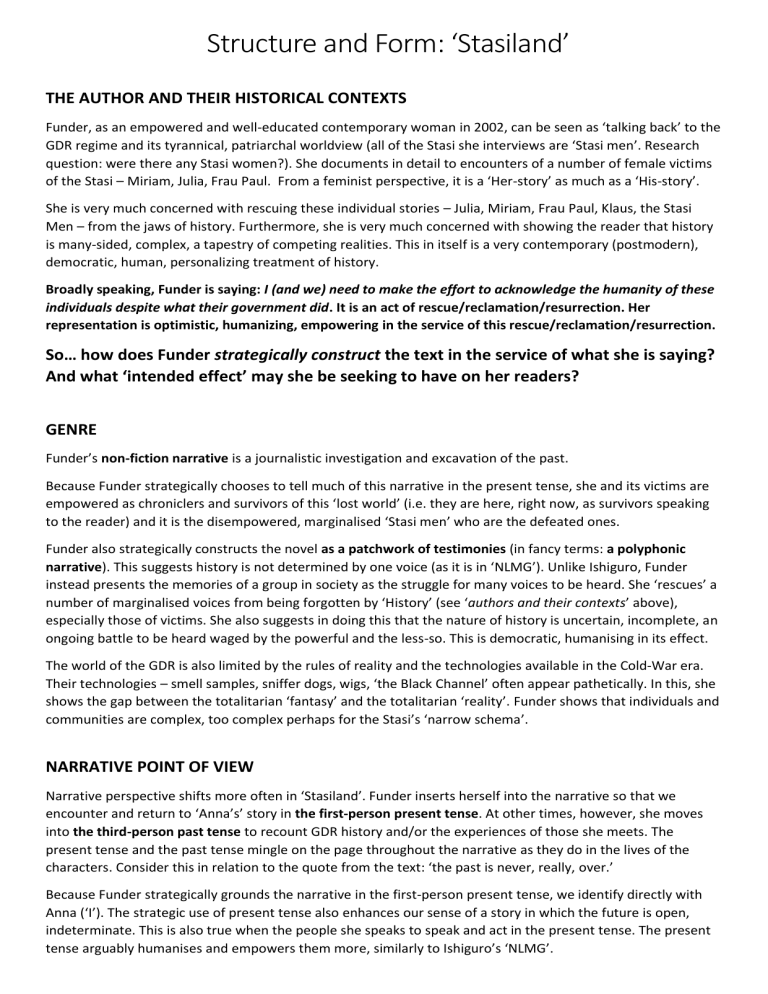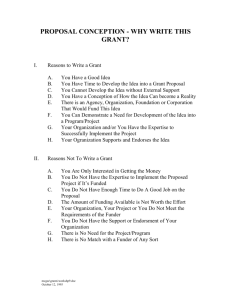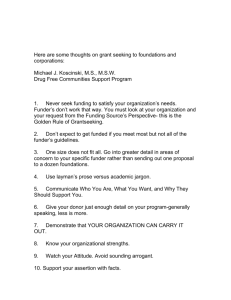
Structure and Form: ‘Stasiland’ THE AUTHOR AND THEIR HISTORICAL CONTEXTS Funder, as an empowered and well-educated contemporary woman in 2002, can be seen as ‘talking back’ to the GDR regime and its tyrannical, patriarchal worldview (all of the Stasi she interviews are ‘Stasi men’. Research question: were there any Stasi women?). She documents in detail to encounters of a number of female victims of the Stasi – Miriam, Julia, Frau Paul. From a feminist perspective, it is a ‘Her-story’ as much as a ‘His-story’. She is very much concerned with rescuing these individual stories – Julia, Miriam, Frau Paul, Klaus, the Stasi Men – from the jaws of history. Furthermore, she is very much concerned with showing the reader that history is many-sided, complex, a tapestry of competing realities. This in itself is a very contemporary (postmodern), democratic, human, personalizing treatment of history. Broadly speaking, Funder is saying: I (and we) need to make the effort to acknowledge the humanity of these individuals despite what their government did. It is an act of rescue/reclamation/resurrection. Her representation is optimistic, humanizing, empowering in the service of this rescue/reclamation/resurrection. So… how does Funder strategically construct the text in the service of what she is saying? And what ‘intended effect’ may she be seeking to have on her readers? GENRE Funder’s non-fiction narrative is a journalistic investigation and excavation of the past. Because Funder strategically chooses to tell much of this narrative in the present tense, she and its victims are empowered as chroniclers and survivors of this ‘lost world’ (i.e. they are here, right now, as survivors speaking to the reader) and it is the disempowered, marginalised ‘Stasi men’ who are the defeated ones. Funder also strategically constructs the novel as a patchwork of testimonies (in fancy terms: a polyphonic narrative). This suggests history is not determined by one voice (as it is in ‘NLMG’). Unlike Ishiguro, Funder instead presents the memories of a group in society as the struggle for many voices to be heard. She ‘rescues’ a number of marginalised voices from being forgotten by ‘History’ (see ‘authors and their contexts’ above), especially those of victims. She also suggests in doing this that the nature of history is uncertain, incomplete, an ongoing battle to be heard waged by the powerful and the less-so. This is democratic, humanising in its effect. The world of the GDR is also limited by the rules of reality and the technologies available in the Cold-War era. Their technologies – smell samples, sniffer dogs, wigs, ‘the Black Channel’ often appear pathetically. In this, she shows the gap between the totalitarian ‘fantasy’ and the totalitarian ‘reality’. Funder shows that individuals and communities are complex, too complex perhaps for the Stasi’s ‘narrow schema’. NARRATIVE POINT OF VIEW Narrative perspective shifts more often in ‘Stasiland’. Funder inserts herself into the narrative so that we encounter and return to ‘Anna’s’ story in the first-person present tense. At other times, however, she moves into the third-person past tense to recount GDR history and/or the experiences of those she meets. The present tense and the past tense mingle on the page throughout the narrative as they do in the lives of the characters. Consider this in relation to the quote from the text: ‘the past is never, really, over.’ Because Funder strategically grounds the narrative in the first-person present tense, we identify directly with Anna (‘I’). The strategic use of present tense also enhances our sense of a story in which the future is open, indeterminate. This is also true when the people she speaks to speak and act in the present tense. The present tense arguably humanises and empowers them more, similarly to Ishiguro’s ‘NLMG’. Furthermore, we hear a range of ‘voices’ throughout the narrative (Miriam, Julia, the Stasi Men, Hagen Koch, etc.) Funder’s incorporation of a multitude of voices also suggests that the past is not determined by one voice). The past is instead presented as the struggle for many voices to be heard. This arguably is a more hopeful, democratic take on history. It furthermore helps to further humanise and give dignity to the victims of the GDR regime. At the same time, it also humanizes the Stasi, knocking them from their pedestal as powerful, faceless villains and instead presenting them such that we may mock (even sympathise with?) their flaws (see: ‘Funder is saying’ on page one). NARRATIVE STRUCTURE The structure of ‘Stasiland’ can be described as episodic and non-linear. Funder strategically constructs the text as a series of episodes strung together, each episode exploring the perspective of a different character/voice. We see this in the chapter titles e.g. ‘Miriam’, ‘Julia has no story’, ‘Klaus’ etc. This episodic structure again enhances the reader’s sense of history as being the product of competing voices, a messy thing, not the clean record of events that ‘NLMG’ is presented as. Funder herself can be seen as a kind of Puzzle-Person ‘working against forgetting, and against time’ as she reconstructs strands of GDR history through personal testimony. Hers, and the Puzzle People’s, is a work of reverse-rectification, the opposite of Kathy’s journey in NLMG. Like that of the Puzzle People, her narrative tapestry can perhaps never be fully completed, but its existence affirms her belief that these individual’s humanity needs to be recognized (see ‘Funder is saying’, p.1). This arguably further serves her aim of giving the reader a more humanistic, optimistic view of history and of the nature of history. The text’s design insists that the story of history belongs as much to the powerless as to the powerful, that in Funder’s words ‘the stories of individual people must be told’. TONE ‘Stasiland’ features surreal humour ( e.g. the ‘smell jars’ in the Runde Ecke; von Schnitzler criticizing ‘Big Brother’; Anna’s description of the Lipsi dance; Julia’s encounter at the unemployment office). Funder’s strategic highlighting of humour in this world further reinforces the statement made by the manager of the Puzzlers that ‘They [the GDR government] wanted to put everything into their narrow schema, but life simply didn’t fit into it.’ This humour forcefully implies to the reader how ridiculous the Stasi’s delusion made them. The humour – Anna’s sometimes mocking take on the Stasi men, that of the victims – can also be regarded as empowering the ‘little people’ in this way. On the endings: it is useful to compare the final paragraphs of each book (perhaps at the end of your essay?) to suggest their tone and their impact on the reader. What final ‘message’ do the books leave their readers with? THE TITLES Funder’s title ‘Stasiland’ echoes ‘Alice in Wonderland’ – it implies that the world of the GDR is a parallel, often absurdist reality that Anna, our ‘Alice’, is forever struggling to comprehend. Funder makes repeated allusions to ‘Alice in Wonderland’ throughout the book. In the opening scene, she first enters a subway (goes down a rabbit hole?) to visit the Runde Ecke museum; at the Runde Ecke, she describes that she ‘shrank like Alice’ at its opening doors (in the original, Alice’s size variously shrinks and expands in her journeys through Wonderland). The sense of absurdism Funder repeatedly injects into the narrative (see Tone) further complements this sense of the GDR as a parallel, surreal reality: ‘a secret, walled in garden’, ‘a land gone wrong’ as Funder describes it at various points. THE SETTINGS In contrast, Funder also implies that the GDR was a parallel world through her ‘Alice in Wonderland’ references (see notes on the Title, above). The landscapes of ‘Stasiland’ variously evoked as grey and crumbling. This urban decay may suggest the crumbling and disppearing of a history that Funder seeks to record: ‘this is work against forgetting, and against time.’ (see ‘Funder is saying’ p.1). In summary, take more of a language-analysis approach to the text: How has the author designed the text? In the service of what big ideas and to what intended effects on their audience? What characters have they included, and how have they chosen to portray them? Again, in the service of what big ideas and to what intended effects on their audiences?



